
Almagul Menlibayeva
Almagul Menlibayeva is a Kazakhstani artist whom splits her time between Kazakhstan and Germany.Her art’s main themes usually revolve around social and ecological issues in Central Asia.
Early life and education
Menlibayeva was born in 1969 in Almaty, the former capital of Kazakhstan.[4] She obtained her MFA degree from Academy of Art and Theatre, Almaty, Kazakhstan in 1992.
Works
Selected solo exhibitions
2016 Solo show, Yay gallery, Baku, Azerbaijan;
2014 Transoxiana Dreams, Videozone, Ludwig Forum, Aachen, Germany;
2013 Empire of the Memory, Ethnographic Museum, Warsaw, Polland;
An Odd tor the Wastelands and Gulags, Kunstraum Innsbruck, Austria;
2012 Daughters of Turan, Casal Solleric, La Palma De Mallorca, Spain;
2011 Exodus, Nassauischer Kunstverein Wiesbaden, Wiesbaden, Germany;
Les rêves perdus d’Aral, Galerie Albert Benamou, Paris, France;
Transoxiana Dreams, Priska C. Juschka Fine Art, New York, NY; My Silk Road to you, Tengri-Umai Gallery, Almaty, Kazakhstan;
2010 Lonely at the Top, Europe at large #6 (Refrains from the Wasteland), Museum van Hedendaagse Kunst (M HKA), Antwerp, Belgium
Daughters of Turan, Priska C. Juschka Fine Art, New York, NY;
2009 Exodus,Tengri-Umai Gallery, Almaty, Kazakhstan; Kurban, Priska C. Juschka Fine Art, New York, NY; 2008 Kissing Totems, Priska C. Juschka Fine Art, New York, NY;
2007 On the Road, Galerie Davide Gallo, Berlin, Germany;
Notable works
Transoxiana Dreams (2011)
Transoxiana Dreams explores the social, economical, and ecological issues surrounding the lives of the Araikum generation – the term used to call the people living in the vast region of the rapidly receding Aral Sea coastline.[6] The deteriorating environment is caused by the radical irrigation policies of the former Soviet Union in the 1960s – between Soviet, Uzbekistan, Tajikistan, and southwestern Kazakhstan.
A dreamy, surrealistic mixture of documentary and fantasy, Transoxiana Dreams explores the desertification through the eyes of a fisherman’s daughter as the main protagonist.The girl’s father encounters strange mythical female creatures during his journey as he ventures for new fishing grounds – scarce leftover of what once was Aral Sea. The mythical creatures – derived from Greek’s mythological figure, the Centaur, was chosen as according to legend, upon their initial meeting, the ancient Greeks mistook the nomads of Transoxianian Steppes on their horses as mythological.
Transoxiana Dreams won the main award at Kino der Kunst 2013 – an international film festival hosted in Munich, Germany.
Milk for Lambs (2010)
The visual of this 11:35 minute video installation is composed of alternating black-and-white and color frames. Milk for Lambs straddles the line between contemporary Kazakhstan and its mythically infused historic ritual.[11] Set against the vast landscape of the steppe, it traces what’s left of Tengriism – where the skygod Tengri is the main deity[12] and his wife, Umai, the all-nurturing mother goddess of the Turkic Siberians.[11] The film follows the former nomads[13] as they celebrate the festivities held in honor of Tengri and Umai, and the accompanying rituals.[3]
Milk for Lambs won KfW Audience Award of the Videonale 13: Festival for Contemporary Art in Kunstmuseum, Bonn.
Kissing Totems (2008)
Kissing Totems is the first solo exhibition Almagul Menlibayeve held in the United States, and the title of the solo exhibition is one of her recent works in 2008 with the same name.
In her film, “Kissing Totems”, it is about a set of surrealist actions and impossible encounters happened on the territory of a deserted factory from the Soviet era. The industrial ruin of Communism has become a stage, a kind of bird, also a totem and peris which mark the transition of dream-narrative. By invoking confounding feelings and curiosity, the artist asks audiences to watch the film through the eyes of a little girl, the audiences observe the unbelievable thing by contemplative detachment. When the little girl walks through the past symbol of Communism, from camera to industrial materialism of industry. At the same time, the little girl feels comfy with two symbol systems. Through her imagine gaze, the post-communism becomes another totemic myth that being occupied by ideologies and the newly revived beliefs.
On the Road (2007)
One the Road is one of Almagul Menlibayeve’s artworks blends in poetry into video and performance that being presented in a unique setting as brings topic of Islamic cultural tradition and contemporary art together. The following is her own artist statement towards On the Road:
“My educational background is in the Soviet Russian avan
Showing all 14 results
-
 out of stock
out of stock
Aral beach, 2011
Almagul MenlibayevaPhotograph by Almagul Menlibayeva, Aral beach, 2011 Aral beach – Beautiful photo by Almagul Menlibayeva, a Kazakhstan-born artist who lives and works in Kazakhstan and Berlin. Menlibayeva creates a poetic blend of video and performance in a unique setting that brings together topics of Islamic cultural tradition and contemporary art, creating a language of so-called Read the full article…
Read more -
 out of stock
out of stock
Aralkum Generation
Almagul MenlibayevaPhotograph by Almagul Menlibayeva, Almaty, Kazakhstan, 2011.
Read more -
 out of stock
out of stock
Body Guards Of Yassavi
Almagul MenlibayevaPhotograph by Almagul Menlibayeva, Almaty, Kazakhstan, 2010.
Read more -
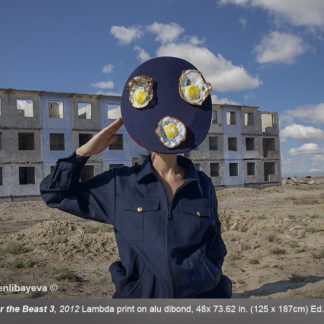 out of stock
out of stock
Breakfast For The Beast
Almagul MenlibayevaPhotograph by Almagul Menlibayeva, Almaty, Kazakhstan, 2012.
Read more -
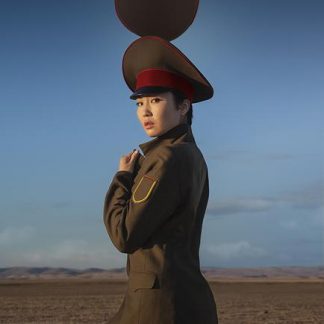 out of stock
out of stock
Camougflage Centaur
Almagul MenlibayevaPhotograph by Almagul Menlibayeva, Almaty, Kazakhstan, 2015.
Read more -
 out of stock
out of stock
Foxy Charmes
Almagul MenlibayevaAlmagul Menlibayeva is a Kazakh artist who shares her time between Israel, Germany and Kazakhstan. The main issues of her art revolve around social and ecological issues in Central Asia. She exhibited around the world at art fairs and biennales in single and joint exhibitions. She has won many awards
Read more -
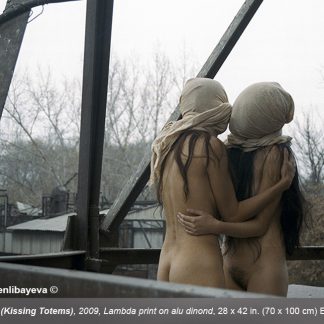 out of stock
out of stock
French Kiss (Kissing Totems)
Almagul MenlibayevaPhotograph by Almagul Menlibayeva, Almaty, Kazakhstan, 2009.
Read more -
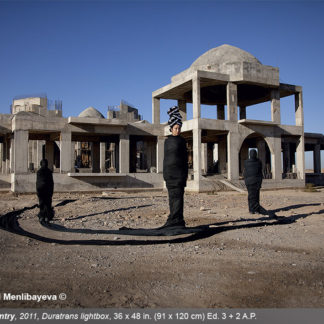 out of stock
out of stock
Global Entry
Almagul MenlibayevaPhotograph by Almagul Menlibayeva, Almaty, Kazakhstan 2011.
Read more -
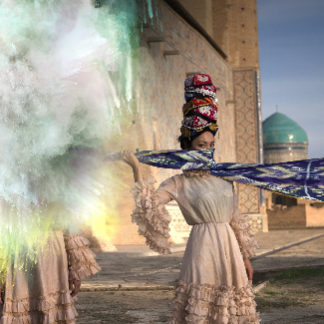 out of stock
out of stock
Just Pull My Memory
Almagul MenlibayevaAlmagul Menlibayeva is a Kazakh artist who shares her time between Israel, Germany and Kazakhstan The main issues of her art revolve around social and ecological issues in Central Asia. She exhibited around the world at art fairs and biennales in single and joint exhibitions. She has won many awards
Read more -
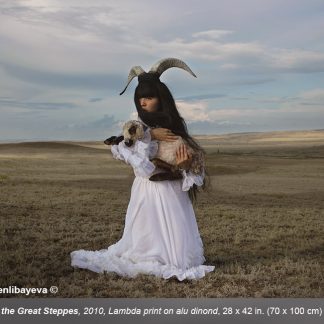 out of stock
out of stock
Madonna of the Great Steppes
Almagul MenlibayevaPhotograph by Almagul Menlibayeva, Almaty, Kazakhstan, 2010.
Read more -
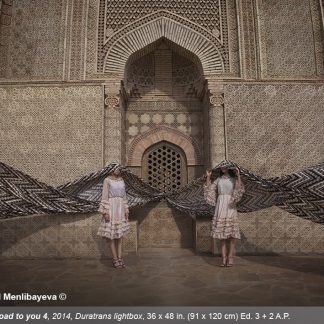 out of stock
out of stock
My Silk Road To You
Almagul MenlibayevaPhotograph by Almagul Menlibayeva, Almaty, Kazakhstan, 2014.
Read more -
 out of stock
out of stock
Peri And Children
Almagul MenlibayevaPhotograph by Almagul Menlibayeva, Almaty, Kazakhstan, 2009.
Read more -
 out of stock
out of stock
Red Butterfly
Almagul Menlibayeva, PhotographPhotograph by Almagul Menlibayeva, Almaty, Kazakhstan, 2012.
Read more -
 out of stock
out of stock
Three Figures
Almagul MenlibayevaPhotograph by Almagul Menlibayeva, Almaty, Kazakhstan, 2012.
Read more
Showing all 14 results